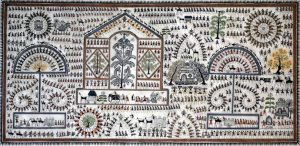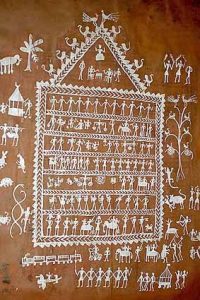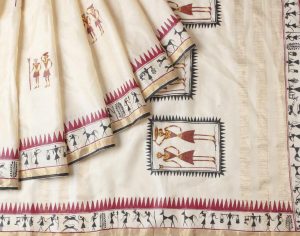By: Dev Tripathy
Saura Art – The Story of an Ancient Indian Tribe through Their Captivating Art.
With simple forms and figures that come together to compose intricate narratives in very few colours, the captivating art of the Sauras, has told the story of the tribe for hundreds of years.
A tribal art-form from the golden land of Odisha, Saura Art started out with its ritualistic beginnings on the walls of village homes, to become one of the most beautiful art-forms that Odisha and India, as well are proud of.

The Sauras are one of India’s oldest tribes, inhabiting the southern part of Odisha. With a history that has been mentioned in the Ramayana and the Mahabharata, the Sauras are known for their distinct tribal culture and their art.

A tribe that is deeply connected to nature, their art on the surface seems to be a simplistic depiction of everyday village life. But the art of the Sauras is rich with symbolism and meaning, and it is through these images and their interpretation that the Saura people hold on to their customs and culture. For the Sauras, whose language does not have a script, their art is a record of their history, their philosophy and religious practices.

Saura Art is traditionally made on the red or brown clay walls of the homes of the villagers, with natural dyes made from rice, white stone, and flower and leaf extracts, using a brush that is made from tender bamboo. The paintings are usually dedicated to the deity of the Sauras, known as Idtal and are made during special occasions like harvest, child-birth, marriage etc, during which they are also worshiped.

The figures in Saura art-works are called icons or ikons and many of them are recurring motifs and symbols, such as people, the tree of life, the sun and moon, horses, and elephants, which all hold their own symbolism. Traditionally, it was only priests who could make these wall-paintings. They would also explain their meanings to the village-folk, passing on their tribal customs and culture in a unique oral tradition.

Saura Art has undergone many transformations in the 21st century. An art that began as murals on mud walls, it is now everywhere, from sarees to notebook covers. It has also acquired a decorative value in recent times, with many people buying Saura art for their homes.

Saura artists have started experimenting with newer mediums too, like acrylics and pen and ink, on more mobile materials like canvas and paper. Another interesting development in Saura Art, and this is a trend seen in other Indian tribal art-forms too, is the subtle entry of modern elements in the imagery and subjects depicted. It is indeed a wonderful thing to look at a primitive art-form that remained unchanged for ages, and then notice a bus in the painting, drawn in the style of the art, looking perfectly in place.
Source: Newspapers, Social Media